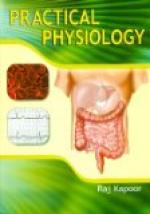147. Minute Structure of the Liver. When a small piece of the liver is examined under a microscope it is found to be made up of masses of many-sided cells, each about 1/1000 of an inch in diameter. Each group of cells is called a lobule. When a single lobule is examined under the microscope it appears to be of an irregular, circular shape, with its cells arranged in rows, radiating from the center to the circumference. Minute, hair-like channels separate the cells one from another, and unite in one main duct leading from the lobule. It is the lobules which give to the liver its coarse, granular appearance, when torn across.
[Illustration: Fig. 58.—Diagrammatic Section of a Villus
A, layer of columnar epithelium covering
the villus;
B, central lacteal of villus;
C, unstriped muscular fibers;
D, goblet cell
]
Now there is a large vessel called the portal vein that brings to the liver blood full of nourishing material obtained from the stomach and intestines. On entering the liver this great vein conducts itself as if it were an artery. It divides and subdivides into smaller and smaller branches, until, in the form of the tiniest vessels, called capillaries, it passes inward among the cells to the very center of the hepatic lobules.
148. The Bile. We have in the liver, on a grand scale, exactly the same conditions as obtain in the smaller and simpler glands. The thin-walled liver cells take from the blood certain materials which they elaborate into an important digestive fluid, called the bile.[23] This newly manufactured fluid is carried away in little canals, called bile ducts. These minute ducts gradually unite and form at last one main duct, which carries the bile from the liver. This is known as the hepatic duct. It passes out on the under side of the liver, and as it approaches the intestine, it meets at an acute angle the cystic duct which proceeds from the gall bladder and forms with it the common bile duct. The common duct opens obliquely into the horseshoe bend of the duodenum.
The cystic duct leads back to the under surface of the liver, where it expands into a sac capable of holding about two ounces of fluid, and is known as the gall bladder. Thus the bile, prepared in the depths of the liver by the liver cells, is carried away by the bile ducts, and may pass directly into the intestines to mix with the food. If, however, digestion is not going on, the mouth of the bile duct is closed, and in that case the bile is carried by the cystic duct to the gall bladder. Here it remains until such time as it is needed.
149. Blood Supply of the Liver. We must not forget that the liver itself, being a large and important organ, requires constant nourishment for the work assigned to it. The blood which is brought to it by the portal vein, being venous, is not fit to nourish it. The work is done by the arterial blood brought to it by a great branch direct from the aorta, known as the hepatic artery, minute branches of which in the form of capillaries, spread themselves around the hepatic lobules.




